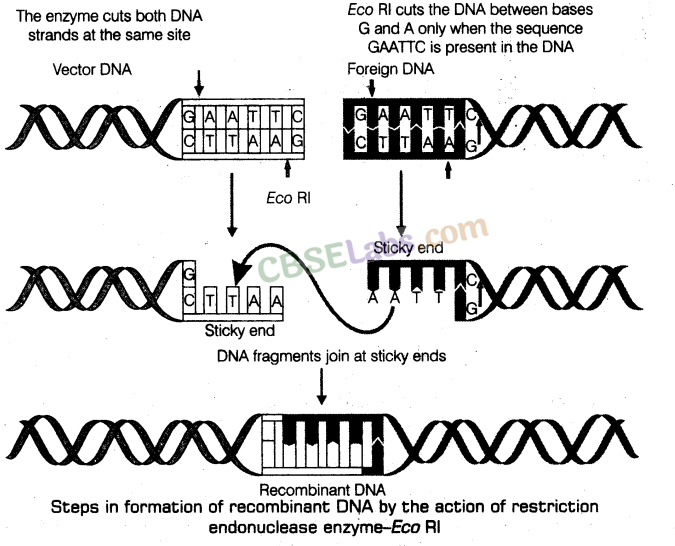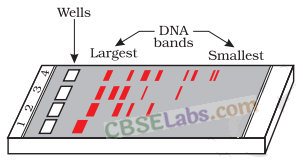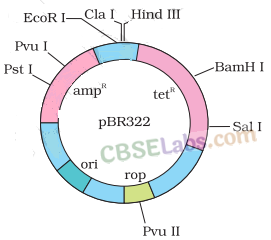Biotechnology: Principles and Processes – CBSE Notes for Class 12 Biology
CBSE Notes CBSE Notes Biology NCERT Solutions Biology
Principles of Biotechnology and Tools of Recombination DNA Technology:
1. Biotechnology
can be defined as the use of microorganisms, plants or animal cells or their components to produce products and processes useful to humans. According to the European Federation of Biotechnology (EFB), biotechnology is the integration of natural science and organisms, cells, parts thereof and molecular analogues for products and services. The term ‘Biotechnology’ was coined by Karl Ereky in 1919.
2. Principles of biotechnology are based on the concept of the following techniques:
(i) Genetic engineering is the technique to alter the chemistry of genetic material (DNA/RNA), to introduce these into another organisms and thus, change the phenotype of the host organism.
(ii) Adequate maintenance of sterile conditions to support growth of only the desired microbes/eukaryotic cells in large quantities for the manufacture of biotechnological products like antibiotics, vaccines, enzymes, etc.
3. The techniques of genetic engineering include the following:
(i) Creation of recombinant DNA by combining desired genes.
(ii) Gene transfer.
(iii) Maintenance of DNA in host and gene cloning.
The basic steps in genetic engineering can be summarised as:
(i) Identification of DNA with desirable genes.
(ii) Introduction of the identified DNA into the host.
(iii) Maintenance of introduced DNA in the host hrtd transfer of the DNA to its progeny.
4. Construction of First Artificial Recombinant DNA
(i) It was achieved by linking a gene encoding antibiotic resistance with a native plasmid (an autonomously replicating circular extrachromosomal DNA) of Salmonella typhimurium.
(ii) Stanley Cohen and Herbert Boyer accomplished this in 1972.
(iii) They isolated the antibiotic resistance gene by cutting out a piece of DNA from a plasmid.
(iv) The cutting of DNA at specific locations was carried out by molecular scissors, i.e. restriction enzymes.
(v) The cut piece of DNA was then linked to the plasmid DNA with the enzyme DNA ligase. The plasmid DNA acts as vectors to transfer the piece of DNA attached to it.
(vi) When this DNA is transferred into E. coli, it could replicate using the new host’s DNA polymerase enzyme and make multiple copies.
(vii) This ability to multiply copies of antibiotic resistance gene in E. coli was called cloning of antibiotic resistance gene in E. coli.
5. Tools of recombinant DNA technology are as follow:
(i) Restriction enzymes (ii) Polymerase enzymes
(iii) Ligases (iv) Vectors
(v) Competent host organism.
6. Restriction enzymes or ‘molecular scissors’ are used for cutting DNA.
(i) Two enzymes from E. coli that were responsible for restricting the growth of bacteriophage were isolated in 1963, one of them added methyl group to DNA and the other cut DNA into segments. The later was called restriction endonuclease.
(ii) The first restriction endonuclease Hind II was isolated by Smith Wilcox and Kelley (1968). They found that it always cut DNA molecules at a particular point by recognising a specific sequence of six base pairs known as recognition sequence.
(iii) Besides Hind II, more than 900 restriction enzymes have been isolated now, from over 230 strains of bacteria, each of which recognise different recognition sequences.
(iv) Naming of Restriction Enzymes
(a) The first letter is derived from the genus name and the next two letters from the species name of the prokaryotic cell from which enzymes are extracted.
(b) The Roman numbers after name show the order in which the enzymes were isolated from the bacterial strain.
For example, Eco RI comes from Escherichia coli RY13 and Eco RII comes from E. coli R 245, etc.
(v) Restriction enzymes belong to a class of enzymes called nucleases.
Nucleases are of two types:
Exonucleases They remove nucleotides from the ends.
Endonucleases They cut at specific positions within the DNA.
(a) Each restriction endonuclease recognises a specific palindromic nucleotide sequences in the DNA.
(b) Palindrome in DNA is a. sequence of base pairs that reads same on the two strands when orientation of reading is kept same.
For example, the following sequences reads the same on the two strands in 5′ -> 3′ direction as well as 3′ -> 5′ direction.
5′ — GAATTC — 3′
3′ — CTTAAG — 5′
(vi) Mechanism of Action of Restriction Enzymes

(a) Restriction enzymes cut the strand of DNA a little away from the centre of the palindrome sites, but between the same two bases on the opposite strands.
(b) This leaves single stranded portions at the ends.
(c) There are overhanging stretches called sticky ends on each strands as given in above figure. These are named so, because they form hydrogen bonds with their complementary cut counterparts.
(d) The stickiness of the ends facilitates the action of the enzyme DNA ligase.
(e) Restriction endonucleases are used in genetic engineering to form recombinant molecules of DNA, which are composed of DNA from different sources/genomes.
(f) These sticky ends are complementary to each other when cut by same restriction enzyme, therefore can be joined together (end-to-end) using DNA ligases.
7. Separation and Isolation of DNA Fragments
(i) The cutting of DNA by restriction’endonucleases results in the fragments of DNA.
(ii) The technique, which separates DNA fragments based on their size is called gel electrophoresis.
(iii) DNA fragments are negatively charged molecules. They can be separated by forcing them to move towards the anode under an electric field through a medium/matrix.
(iv) The most common medium used is agarose, a natural polymer extracted from sea weeds.
(v) The DNA fragments separate (resolve) according to their size through sieving effect provided by the agarose gel. The smaller the fragment size, the farther it moves.

(vi) The separated DNA fragments can be visualised only after staining the DNA with a compound known as ethidium bromide followed by exposure to UV radiation.
(vii) The DNA fragments can be seen as bright orange coloured bands. These separated bands are cut out from the agarose gel and extracted from the gel piece. This is called elution.
(viii) The purified DNA fragments can be used in constructing recombinant DNA by joining them with cloning vectors.
8. Cloning vectors
are the DNA molecules that can carry a foreign DNA segment into the host cell.
(i) The vectors used in recombinant DNA technology can be:
(a) Plasmids Autonomously replicating circular extra-chromosomal DNA.
(b) Bacteriophages Viruses infecting bacteria.
(c) Cosmids Hybrid vectors derived from plasmids which contain cos site of X phage.
(ii) Copy number can be defined as the number of copies of vectors present in a cell.
(iii) Bacteriophages have high number per cell, so their copy number is also high in genome.
(iv) Plasmids have only one or two copies per cell.
(v) Copy number can vary from 1-100 or more than 100 copies per cell.
(vi) If an alien piece of DNA is linked with bacteriophage or plasmid DNA, its number can be multiplied equal to the copy number of the plasmid or bacteriophage.
(vii) Features Required to Facilitate Cloning into Vector
(a) Origin of replication (Ori) (b) Selectable marker
(c) Cloning sites (d) Vectors for cloning genes in plants and animals.
(a) Origin of replication (Ori) is a sequence from where replication starts.
• Any piece of DNA when linked to this sequence can be made to replicate within the host cells.
The sequence is also responsible for controlling the copy number of the linked DNA.
(ii) Selectable marker helps in identifying and eliminating non-transformants and selectively permitting the growth of the transformants.
• Transformation is a process through which a piece of DNA is introduced in a host bacterium.
• The genes encoding resistance to antibiotics such as ampicillin, chloramphenicol, tetracycline or kanamycin, etc, are some useful selectable markers for E. coli.

• Ligation of alien DNA is carried out at a restriction site present in one of the twoantibiotic resistance genes. Example is ligating a foreign DNA at the Bam HI site of tetracycline resistance gene in the vector pBR322.
-» The recombinant plasmids will lose tetracycline resistance due to insertion of foreign DNA. But, it still can be selected out from non-recombinant ones by plating the transformants on ampicillin containing medium.
-» The transformants growing on ampicillin containing medium are then transferred on a medium containing tetracycline.
-» The recombinants will grow in ampicillin containing medium but not on that containing tetracycline.
The non-recombinants will grow on the medium containing both the antibiotics.
In this example, one antibiotic resistance gene helps in selecting the transformants whereas, the other antibiotic resistance gene gets ‘inactivated due to insertion’ of alien DNA and helps in selection of recombinants.
* Selection of recombinants due to inactivation of antibiotics is a cumbersome procedure, so alternative selectable markers are developed which differentiate recombinants from non-recombinants on the basis of their ability to produce colour in the presence of a chromogenic substrate.
-» In this method, a recombinant DNA is inserted within the coding sequence of an enzyme J3-galactosidase.
-» This results into inactivation of the enzyme, P-galactosidase (insertional inactivation).
-> The bacterial colonies whose plasmids do not have an insert, produce blue colour, but others do not produce any colour, when grown on a chromogenic substrate.
(c) Cloning sites are required to link the alien DNA with the vector.
• The vector requires very few or single recognition sites for the commonly used restriction enzymes.
• The presence of more than one recognition sites within the vector will generate several fragments leading to complication in gene cloning.
(d) Vectors for cloning genes in plants and animals are many which are used to clone genes in plants and animals.
• In plants, the Tumour inducing (Ti) plasmid of Agrobacterium tumefaciens is used as a cloning vector.
-» Agrobacterium tumefaciens is a pathogen of several dicot plants.
-» It delivers a piece of DNA known as T-DNA in the Ti plasmid which 1 transforms normal plant cells into tumour cells to produce chemicals
required by pathogens.
• Retrovirus, adenovirus, papillomavirus are also now used as cloning vectors in animals because of their ability to transform normal cells into cancerous cells.
9. Competent host organism
(for transformation with recombinant DNA) is required because DNA being a hydrophilic molecule, cannot pass through cell membranes, Hence, the bacteria should be made competent to accept the DNA molecules,
(i) Competency is the ability of a cell to take up foreign DNA.
(ii) Methods to make a cell competent are as follow.
(a) Chemical method In this method, the cell is treated with a specific concentration of | a divalent cation such as calcium to increase pore size in cell wall.
The cells are then incubated with recombinant DNA on ice, followed by placing them briefly at 42°C and then putting it back on ice. This is called heat shock treatment.
• This enables the bacteria to take up the recombinant DNA.
(b) Physical methods In this method, a recombinant DNA is directly injected into the nucleus of an animal cell by microinjection method.
• In plants, cells are bombarded with high velocity microparticles of gold or tungsten coated with DNA called as biolistics or gene gun method.
(c) Disarmed pathogen vectors when allowed to infect the cell, transfer the recombinant
DNA into the host.
NCERT Solutions Maths Physics Chemistry Biology Science